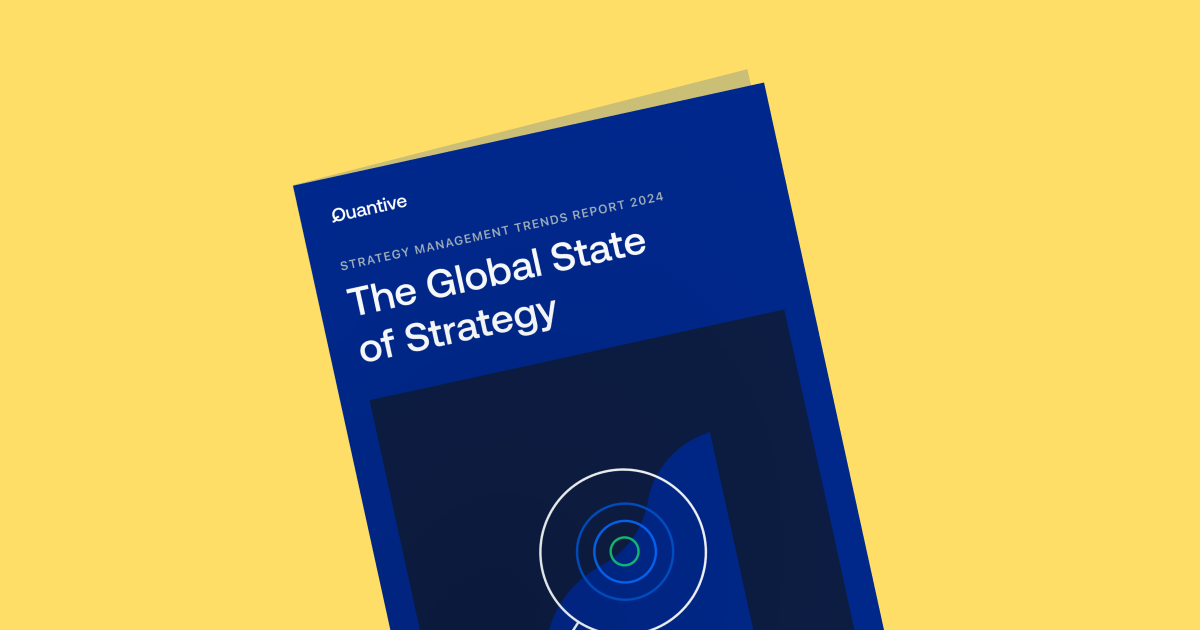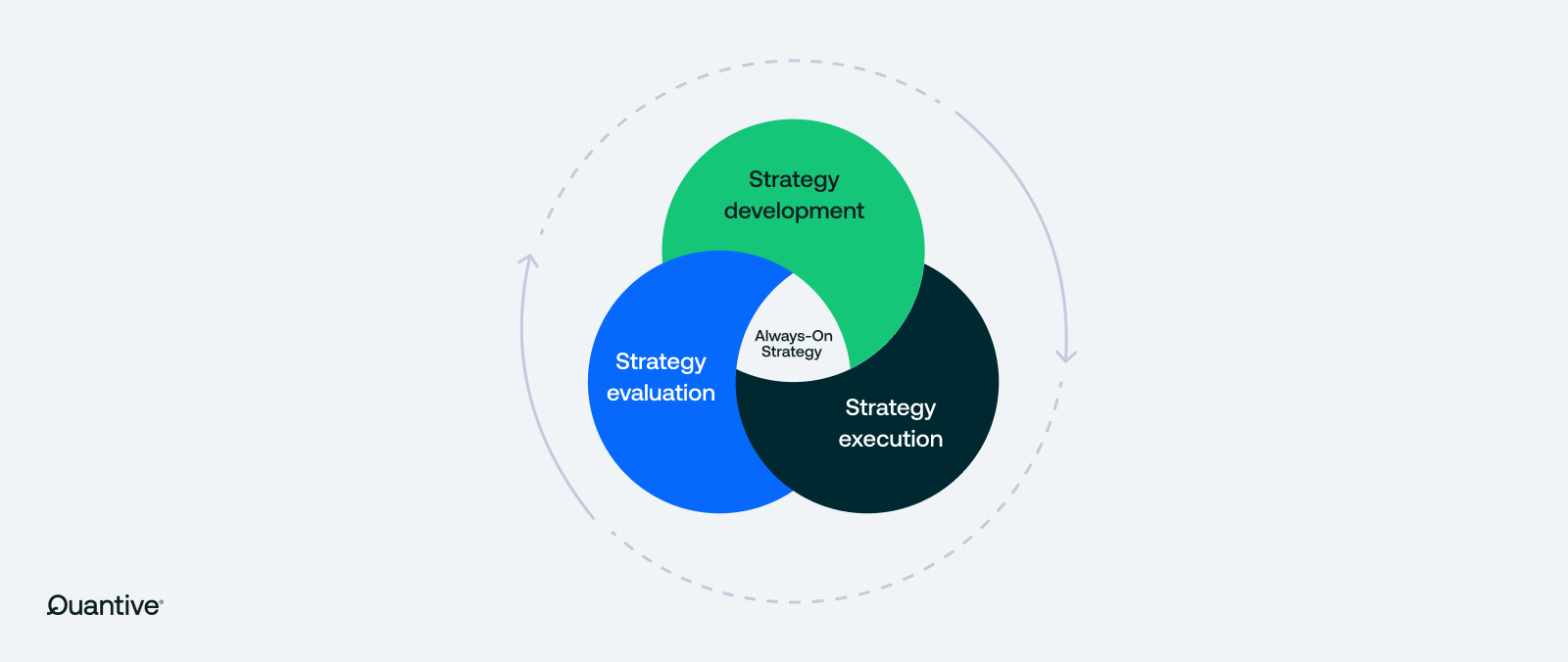Businesses have had a whirlwind of disruptions over the past few years. From pandemics and supply chain disruptions to interest rate hikes, fluctuating energy prices, geopolitical tensions, and the rise of generative AI, the market has become a minefield of unexpected disturbances.
While market volatility persists, the process of crafting business strategies remains largely unaltered. Although experts and thought leaders like BCG, Drucker, and Porter have built upon this process, its core remains constant:
Each year, a group of executives sift through heaps of data to set a future business strategy, usually one to three years ahead — sometimes stretching to five or ten years. They then communicate this strategy down the organization, leaving teams scrambling to align and contribute to meet these goals.
This approach views organizations as predictable systems, setting strategies based on assumed certainties in a supposedly known future. However, it’s completely disconnected in today’s uncertain business environment.
“In the digital age, sitting down once a year to do anything is weird, it's just bizarre.”
– Jeff Immelt, CEO of GE
The need for a new strategic approach
Once practical, the traditional way of strategy development now creates a strategy execution gap. The strategy execution gap is the misalignment between a company’s strategic aims and practical application, resulting in a stagnant, inefficient strategy that’s disconnected from present realities.
This stems from this outdated strategic process’s multiple weaknesses:
- Infrequent strategy development: Annual or sporadic strategy formulation renders it dated upon implementation
- Outdated data: Strategy development lacks real-time responses due to reliance on outdated data
- Human-led limitations: Constraints in processing and analyzing information lead to incomplete or biased insights
- Influence of intuition: Heavy reliance on executives' intuition as opposed to accurate data causes blind spots in assessing operations and risks
- Lack of measurement: Inadequate follow-up and monitoring post-deployment
- Infrequent optimization: Rare adjustments in response to market changes render strategies disconnected from the business's current state
These weaknesses add up, leading to significant business problems like losing competitive edge, declining profits, inefficiencies, limited innovation, and customer churn. Staying competitive requires a dynamic strategy approach that tackles uncertainty while emphasizing agility — we call this the Always-On Strategy model.
Discover the current state of strategy in our 2024 report

What is Always On Strategy?
The Always-On Strategy model bridges the strategy execution gap using a continuous, rapid, and iterative loop of strategy development, execution, and evaluation. Its connected, data-driven, and agile nature encourages informed strategic decisions, faster execution and time to value, and ongoing alignment with market demands.
At its core, the model embraces the fluidity of today’s business landscape. It acknowledges that change is not just continuous but rapid. Rather than depending on dated, set-term plans, this model empowers businesses to tweak their strategy using real-time insights. Its inherent feedback cycles refine and optimize strategy continuously, ensuring it stays relevant and timely.
Let’s break down the Always-On Strategy by examining its three components:
- Strategy development – direct your business
- Strategy execution – change your business
- Strategy evaluation – evaluate your business
Component 1: Strategy development
The first phase of Always-On Strategy optimization is making sure you have a strategy. This involves developing a robust, adaptable, and responsive strategy that minimizes risks and maximizes adaptability. This requires an acute awareness of the business environment, including market trends, consumer behaviors, and emerging technologies.
Key activities during strategy development include:
- Real-time strategic context analysis: Use advanced technology for dynamic data analysis and informed, timely, and responsive strategic decision-making
- Inclusive decision-making: Engage insights from across the organization to create a comprehensive strategy that fosters understanding and ownership
- Executive team collaboration and strategy formulation: Executives convene annually to collaboratively formulate the business strategy, using technology for ongoing discussions, risk assessment, and idea reconciliation
- Hypothesis testing: Assess potential outcomes under various scenarios to mitigate risk and create robust mitigation plans to future-proof your strategy
- Activation readiness: Create a strategy with vision and top-level execution in mind, ensuring clarity and actionability
“The faster the rate of change, the more adaptability becomes a key imperative.”
– Ian Cox, Senior Director, Analyst, Gartner
Read more on strategy development

Component 2: Strategy execution
In the second phase, the focus shifts to addressing the strategy execution gap. This means aligning and translating strategy into actionable steps for smooth implementation, ensuring a seamless move from planning to execution in line with the environment.
The main elements of successful strategy execution include the following:
- Organizational alignment: Align roles and responsibilities across teams and functions for outcome-driven execution
- Transparency and focus: Drive focus and unified vision through open communication and result visibility
- Communication: Keep stakeholders updated on goals and progress for effective execution and alignment across the board
- Adaptive execution: Maintain agility to navigate unforeseen challenges or changes during strategy execution
Component 3: Strategy evaluation
The last phase of the Always-On Strategy model involves a constant, data-backed evaluation of your dynamic strategy. It involves regularly checking performance metrics to create a continuous feedback loop that steers ongoing actions and decisions.
Crucial aspects of strategy evaluation include:
- Aligning strategic objectives to measurement: Track your objectives’ progress to understand how things are going and improve performance
- KPI integration: Facilitate precision and actionable insights by aligning key performance indicators (KPIs) with strategic objectives and the work being done
- Democratization of data: Enable access to strategy-measurement data and analytics for informed decision-making across the organization
- Iterative strategy development: Leverage real-time insights on a rolling basis to optimize strategy development, ensuring the strategy’s relevance while maximizing opportunities

The power of continuous adaptation
Continuous adaptation isn’t an option when it comes to strategy — it’s vital for success. The Always-On Strategy model relies on ongoing adaptation to respond to market disruptions and thrive accordingly.
Let’s take a closer look at the primary advantages of integrating continuous planning and adaptation within your organization:
- Agility: Swiftly address and accommodate market shifts, honing business agility and responsiveness
- Innovation: Modernize internal processes and nurture a creative work culture for innovative solutions
- Resilience and longevity: Succeed amid dynamic market conditions, ensuring long-term viability and sustainability
- Customer-centric approach: Closely align offerings to changing customer needs, enhancing satisfaction and loyalty
- Engagement: Drive stakeholder engagement while applying relevant insights to ensure commitment, accountability, and ownership, facilitating progress and shared success
- Resource optimization: Ensure effective resource allocation, minimizing waste and maximizing productivity for remarkable outcomes
"The greatest danger in times of turbulence is not the turbulence — it is to act with yesterday's logic."
– Peter Drucker
Future-proof your business with an Always-On Strategy
The Always-On Strategy model sees strategy as an ongoing journey, while keeping a close pulse on results in the here and now. It helps you shape a dynamic strategy that responds to what’s happening inside and outside your company, keeping you ahead in a swiftly changing market.
To adopt an Always-On Strategy successfully, consider leveraging AI-powered solutions specifically designed for dynamic strategy management. The right solution can optimize the management of your Always-On Strategy, enabling you to wholly and effectively deliver all of your business’ potential.
Quantive Strategies pairs AI with your business data to design, deploy, and continually enhance an Always-On Strategy for your business. By empowering you to make better strategic decisions faster, Quantive Strategies accelerates strategy development, simplifies strategic planning, and reduces business risks.
Quantive empowers modern organizations to turn their ambitions into reality through strategic agility. It's where strategy, teams, and data come together to drive effective decision-making, streamline execution, and maximize performance.
As your company navigates today’s competitive landscape, you need an Always-On Strategy to continuously bridge the gap between current and desired business outcomes. Quantive brings together the technology, expertise, and passion to transform your strategy from a static plan to a feedback-driven engine for growth.
Whether you’re a visionary start-up, a mid-market business looking to conquer, or a large enterprise facing disruption, Quantive keeps you ahead — every step of the way. For more information, visit www.quantive.com.


